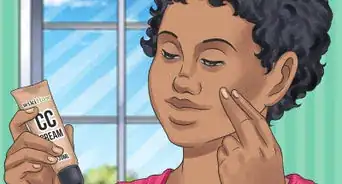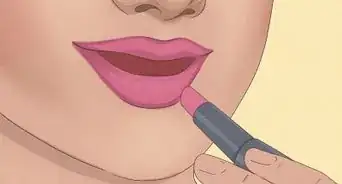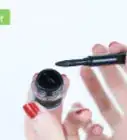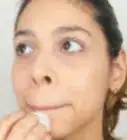This article was co-authored by Melissa Jannes. Melissa Jannes is a Licensed Esthetician and the owner of Maebee's Beauty Studio in Philadelphia, a single practitioner space providing quality services with individualized attention. Melissa is also a National Educator for Universal Companies. She received her esthetics degree at The Beauty School of Middletown in 2008 and is licensed in both New York and Pennsylvania. Melissa won the "Best of Beauty" award from Allure magazine in 2012 for the quality of her bikini waxing.
There are 11 references cited in this article, which can be found at the bottom of the page.
wikiHow marks an article as reader-approved once it receives enough positive feedback. This article received 61 testimonials and 83% of readers who voted found it helpful, earning it our reader-approved status.
This article has been viewed 6,665,157 times.
If you’ve never applied makeup before, all the different products and tools can be intimidating. Don’t worry. We will walk you through it step by step below. Once you get the hang of it, applying makeup to your face will be a breeze.
Steps
Preparing Your Face
-
1Remove any old makeup. When you’re applying makeup, it is necessary to start with a clean palette.[1] Remove any makeup that you might have slept in, and wash off makeup from earlier on in the day. If you try to apply more makeup over the top of old makeup (not including touch ups), your end look will appear caked on and more unnatural than makeup put on a fresh face. You also need to cleanse any makeup residue to keep your skin from getting clogged and irritated. You can use a good makeup remover or a mild baby oil to get rid of all makeup residues.
- Keep in mind that you should always remove your makeup at the end of the day; sleeping with your makeup on can clog your pores and cause blemishes and wrinkles.[2]
-
2Wash your face, then follow with moisturizer. For the same reason you remove your old makeup, you should also wash your face. Use a mild facial cleanser to gently wash your face, spending about one minute of massaging to remove all bacteria and dead skin cells in your pores before rinsing with cool water. Finish up by applying a facial moisturizer, regardless of your skin type.Advertisement
-
3Prime your face. Before you add any makeup you need to prime your face. The purpose of a face primer is to enhance the appearance of makeup and increase the longevity.[3] You can apply the primer with your fingers, covering your whole face with a small amount. The primer will also help your makeup up stay on all day. If you are going to sweat, run, or do anything that will cause your makeup to wear off or smear, primer is a necessity for you.
-
4Put on a coat of foundation. There are several types of foundation[4] , but they are generally applied the same way. Liquid, cream, and powder foundations all act to create a more even complexion, working to create an even base for your other makeup. Use a foundation brush or damp beauty sponge to apply foundation to your face, blending into your neck and earlobes if necessary. Keep in mind that your foundation should be the same color as your natural skin tone, not much darker or lighter. It helps to match your foundation to your chest and neck so your face isn't a different color than the rest of your body. You never want a harsh line from your jawline to your neck. This is very unnatural and gives a harsh and unblended finish, which is not what you want. Choosing a color that matches your skin always helps.
- You can use a concealer brush to add a little extra foundation to cover up stubborn blemishes.
- Liquid foundation can be applied with your fingertips, although this is more likely to introduce bacteria to your skin and cause future breakouts.
-
5Apply some concealer. The purpose of concealer is to even out uneven skin tone as a result of blemishes or dark under-eye circles. You can also use a concealer in a shade slightly lighter in your skin tone to brighten dark areas or high points of your face. Use a concealer brush or your (clean) fingertips to blend concealer on your undereye area in an upside-down triangle shape, down the bridge of your nose, chin, the center of the forehead, and above the upper lip. You can use a shade matching your skin tone to cover any red areas or over any acne or dark spots. Blend the edges of your concealer so it seamlessly blends into your foundation.
-
6Set your foundation and concealer. This step is optional, but if you’re looking for long-lasting, crease-free makeup you should use a setting powder to hold your foundation and concealer in place. Use a damp beauty sponge to pick up loose powder and press into the under-eye area, then gently sweep off any excess with a brush. Use a large, fluffy brush to cover your whole face in a translucent or matching setting powder. This step is particularly useful if you’re using liquid foundation, as it will help to set the foundation and remove any shine or tackiness
-
7Apply a highlighter. With your foundation completed, it is likely that your face now looks contour-less and flat because of the uniform color. In order to provide some depth, you’ll need to create the illusion of highlights and shadows.[5] You can use a cream (apply before you set your face) or powder highlighter to brighten up the deepest areas of your face: the inside corners of your eyes, underneath your eyebrows, in the center of your cupid’s bow, and on the tops/sides of your cheekbones. This will make your face look more bright and awake than it would otherwise.
- Create a ‘3’ shape on your cheekbones, into your eyebrows, and up to your forehead for the perfect highlight.
- You can use your fingers or a small highlighter brush to apply the highlighter.
-
8Add depth with contouring. The opposite of bringing out the highlights on your face, contouring involves adding a powder that is a few shades darker than your actual skin tone (different than a bronzer) to the areas you want to look minimized or further away. Typically, you should contour under your cheekbones in the hollows of your cheeks, on the sides of your nose, and under your jawline.[6] You can also make a large forehead appear smaller by applying contour near your hairline. This will make your face look thinner and longer in appearance, and provide the shadows that naturally occur without foundation. After you contour your face, you can go in with bronzer to add color to your face. Use a big bronzing brush and buff out your bronzer right over where you contoured.
-
9Apply a little blush. The final step in prepping your face is to add blush to your cheeks. Everyone’s cheeks have a bit of color, but this color varies for every person. Apply your blush with a large brush on the apples of your cheeks (the round part that forms when you smile). Don’t go too heavy with your blush, just add enough to replenish the color that would form naturally.
-
10Fill in your eyebrows. This step is optional depending on the fullness of your eyebrows but is generally recommended for those who have thin or sparse eyebrows. Select a color of brow pencil, powder, or pomade that is close to your natural hair color. Start by outlining the edges of your eyebrows with small dashing motions to mimic hair, and then fill in the center using the same small strokes. Go in the same direction of your hair growth, and set with a clear or tinted brow gel to make them stay all day.
Adding Your Eye Makeup
-
1Apply an eyeshadow primer.[7] This is another optional product, but applying an eyeshadow primer will help your eyeshadow to stay on for much longer. If you’ve gone without it, you may have noticed that your eyeshadow fades or becomes oily and collects in the creases of your eyelids after several hours. Use your fingertip to dab on your eyeshadow primer, blending it from the roots of your lashes to the top of your crease. Set with a powder to make a perfect base for blending your eyeshadow.
-
2Put on your eyeshadow. There are many ways to apply eyeshadow, although the most basic and classic look is to apply a single color over the entirety of your eyelid. Use an eyeshadow brush (or finger for higher pigmentation) to apply your eyeshadow to your eyelid, starting in the center near your lash line and blending outwards. Fade your eyeshadow into your natural skin tone near your crease and the inside and outside corners of your eyes, to prevent any harsh lines from forming. If you want a bit more dramatic look, apply a second darker matte color of eyeshadow in a ‘C’ shape from the outside corner of your lash line up to the top, outer ⅓ of your eyelid crease. Finish by sweeping a lighter shimmer color starting from the inner corner and ending in the middle, blending with the rest.
- Your main color of eyeshadow should never go all the way to your eyebrow, and should not extend further off your lid then the end of your eyebrow (unless you’re going for a very dramatic look).
- You may, however, highlight your browbone (the area under your eyebrow but above your crease) by applying a lighter shade of eyeshadow. Be sure to use natural colors such as cream, sand, or white, if your skin is pale. Alternatively, try a nude shade slightly lighter than your skin tone. The color doesn't have to be matte, but any sparkle it does have should be subtle.
- You can blend your eyeshadow onto your lower lid, sweeping the shadow along the lower lash line starting from the outside corner. Blend well so you don't have a harsh line.
- If you use multiple colors of eyeshadow, always be sure to blend them together.
-
3Apply your eyeliner. The purpose of eyeliner is to provide the illusion of a fuller lash line; therefore, choose a color that is similar to your natural hair color (or brown if you have blond hair) to go along your lashes.[8] For a smudgy look, use an eyeliner pencil, or create a sleek and smooth look by using cream or liquid eyeliner. Create a dashed or dotted line across your lash line, and then connect the dots to create a full, continuous line. You can choose to wing the end up and outwards a bit if you want, otherwise you simply need to follow your lash line from the inside corner to the outside corner.
- Adding eyeliner to your bottom lash line should be done sparingly, as it will create a much darker/bolder look and appear a bit more unnatural than eyeliner on your top lash line only.
- If you feel comfortable, try tight-lining your eyes by using your eyeliner on the waterline of your eyelid.
-
4Finish off with mascara. To complete your eye makeup, you’ll need to top off your eyes with a bit of mascara. There are several mascaras to choose from depending on the look you want; if you have short lashes, use a mascara that will add length, or if you have thin lashes, use a volumizing mascara. Dip the brush in the mascara once and lightly wipe off the excess onto the edge of the container or a paper towel. Looking straight forward, apply it to the top lash with upward strokes. Start with the inner part of your eye and work your way outward. Do both eyes with two coats, then let dry. You can also apply mascara to your bottom lashes if you like. [9]
- Wiggle the brush as you apply it, as this will help to coat between lashes instead of just the under layer.
- Never pump your mascara brush in and out of the mascara, as this causes air pockets.
- Avoid applying more than two coats of mascara, as this will take away the natural darkening look and give a cakey thick look that is much less natural.
- A good trick for making your lashes look fuller is to apply a coat of baby powder between coats of mascara; this will add a bit of length and volume to your lashes.
Adding Color to Your Lips
-
1
-
2Apply lip liner. Line your lips with a liner that matches your lip color or the color you are going to apply.[10] Sharpen your lip liner, and line around the natural line of your lips. With your lips outlined, use the pencil to continue filling in your lips. This works to even out the color and texture of your lips, making it easier to apply a gloss or lipstick later.
-
3Apply lipstick or lip gloss with a brush or straight from the tube. Select a lipstick or gloss of your choice to go over your lipliner; for a natural look stick with a nude shade, or pick a bright hue for a more bold appearance. Start in the center of your lip, and blend the color outwards. Be sure to apply the color as close to the edges of your lips as you can without overdoing it and going outside your lip line. To prevent any lipstick from getting on your teeth, stick your index finger straight into your mouth and pull it out quickly; any excess color will stick to your finger and avoid being transferred to your teeth later on.
-
4Finish off your look. With the completion of your lips makeup, your look is finished! Give yourself a once-over to make sure there aren’t any smudges or loose eyeshadow that needs to be removed with a fluffy brush. If you do have any mistakes, use a q-tip dipped in makeup remover to rectify them.[11]
- After you have applied all of the makeup you desire, you should set your face with a setting spray. Simply hold the bottle 8–12 inches (20.3–30.5 cm) away from your face and spray 4-5 times on your whole face. Now your makeup will stay on longer than ever!
Makeup Application Chart
Expert Q&A
Did you know you can get expert answers for this article?
Unlock expert answers by supporting wikiHow
-
QuestionWhere do I start with makeup?
 Melissa JannesMelissa Jannes is a Licensed Esthetician and the owner of Maebee's Beauty Studio in Philadelphia, a single practitioner space providing quality services with individualized attention. Melissa is also a National Educator for Universal Companies. She received her esthetics degree at The Beauty School of Middletown in 2008 and is licensed in both New York and Pennsylvania. Melissa won the "Best of Beauty" award from Allure magazine in 2012 for the quality of her bikini waxing.
Melissa JannesMelissa Jannes is a Licensed Esthetician and the owner of Maebee's Beauty Studio in Philadelphia, a single practitioner space providing quality services with individualized attention. Melissa is also a National Educator for Universal Companies. She received her esthetics degree at The Beauty School of Middletown in 2008 and is licensed in both New York and Pennsylvania. Melissa won the "Best of Beauty" award from Allure magazine in 2012 for the quality of her bikini waxing.
Licensed Esthetician & Brazilian Wax Educator
-
QuestionHow can you get rid of clumps in mascara?
 Community AnswerFill a heatproof mug or cup with near boiling water. Just make sure it's not too hot, if you can drink it, the temperature should be good. Close your mascara firmly and swirl it in the water for about 5 minutes. That should loosen up the particles and liquefy so that it works smoothly again.
Community AnswerFill a heatproof mug or cup with near boiling water. Just make sure it's not too hot, if you can drink it, the temperature should be good. Close your mascara firmly and swirl it in the water for about 5 minutes. That should loosen up the particles and liquefy so that it works smoothly again. -
QuestionHow do I know what colors suit me best (for eyeshadow and lipstick specifically)?
 Community AnswerIf you are a brunette, your best makeup includes berry shades on your lips. Your eyeshadow should be pretty neutral, nothing too bold. A two-toned blush is also ideal. If you have red hair, coral, bright pink, or orange lipsticks or glosses will look best on you. Browns, whites, nudes, and grays will look best on your eyes. If you are a blonde, you will look best in shimmery pink lips and marbled blushes. Don't be afraid to try a sparkly eyeshadow.; it will highlight the golden tones in your hair. If you have black hair, try sticking with nude-coloured palettes on your lips and eyelids. Your lashes will look great, especially if you apply mascara. Gold will also look stunning on your eyes.
Community AnswerIf you are a brunette, your best makeup includes berry shades on your lips. Your eyeshadow should be pretty neutral, nothing too bold. A two-toned blush is also ideal. If you have red hair, coral, bright pink, or orange lipsticks or glosses will look best on you. Browns, whites, nudes, and grays will look best on your eyes. If you are a blonde, you will look best in shimmery pink lips and marbled blushes. Don't be afraid to try a sparkly eyeshadow.; it will highlight the golden tones in your hair. If you have black hair, try sticking with nude-coloured palettes on your lips and eyelids. Your lashes will look great, especially if you apply mascara. Gold will also look stunning on your eyes.
Warnings
- Wash your brushes and sponges with soap and water and allow to dry overnight. Bacteria and oils will collect on these and cause breakouts later.⧼thumbs_response⧽
Things You'll Need
- Good natural lighting
- Mirrors
- Makeup brushes
- Beauty sponge
- Mascara
- Eyeliner
- Primer
- Foundation or tinted moisturizer
- Concealer
- Powder (loose or pressed)
- Eyeshadow
- Lipstick
- Lip balm
- Lip gloss
- Moisturizer
- Setting spray
References
- ↑ https://www.makeup.com/the-ultimate-makeup-tutorial
- ↑ https://www.huffpost.com/entry/sleep-in-makeup_n_2289084
- ↑ https://www.huffpost.com/entry/what-is-makeup-primer-do-you-need-it_n_5a3b390ae4b0b0e5a79f8680
- ↑ https://www.byrdie.co.uk/types-of-makeup-foundations
- ↑ https://www.byrdie.co.uk/how-to-apply-highlighter-tutorial
- ↑ https://www.elle.com/beauty/news/a28308/how-to-contour-pro/
- ↑ https://www.ogleschool.edu/blog/a-beginners-guide-to-eye-makeup/
- ↑ https://www.bobbibrowncosmetics.com/how-apply-eyeliner-pro
- ↑ http://www.realsimple.com/beauty-fashion/makeup/how-to-apply-makeup-00000000053298/
About This Article
To apply makeup, first prepare your skin by applying a light moisturizer or sunblock followed by a makeup primer. This will protect your skin and help your makeup last longer. Next, use a sponge, makeup brush, or lightly dampened beauty blender to apply a light layer of foundation. Then, use concealer to cover any blemishes. A green concealer helps reduce the appearance of redness, and a light concealer helps brighten under the eyes and dark spots. To emphasize your cheekbones, nose, and jawline, consider contouring. Simply dust bronzer along your temples, the hollow of your cheeks, and the sides of your nose. Then, dab highlighter on your cheekbones, the tip of your nose, and the tip of your chin. To add some more color, you can also apply blush to the apples of your cheeks in an upward sweeping motion. For your eyebrows, start by gently brushing them in short, outward strokes. Line the outer edges of your brows with a colored brow gel, powder, or pencil to accentuate the natural shape of each brow. Finish with a clear brow gel to hold them in place. For your eyes, start by applying a light dab of concealer or eyeshadow primer to your eyelids. Then, using a brush or your finger, dust eyeshadow in a light circular motion. Start from the center of your lid and work your way outward toward each corner of your eye. Then, with a steady hand, use a liquid or pencil eyeliner along your upper lash line. For a more dramatic look, consider winging the tips of your liner up and out. For an edgier look, you can smudge pencil eyeliner around the outer corner of your top and bottom lash lines using a q-tip or your finger. For a daytime look, consider using white eyeliner along the waterline of your eyes to make eyes look bigger. Finish your eyes with one to two coats of mascara. Finally, apply your favorite lipstick or lip gloss, and you’re ready to go! To learn more makeup tips, read on!



















































